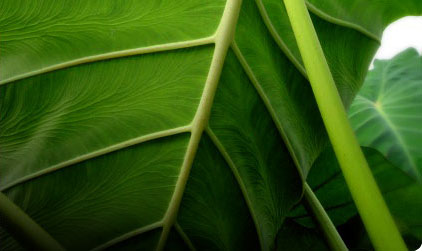Use As Food
Primarily as a table taro. The Hawaiian Dictionary states the kalo cannot be eaten either cooked or as fresh poi without throat irritation. After fermentation, however, the poi is tasty.
Distribution
Little is grown except for some plantings in Puna, Hawai‘i, usually under māla (upland) culture.
General Characteristics
Medium in height, moderately spreading, maturing within 9 to 12 months, producing from 2 to 5 ‘ohā; distinguished by somewhat crinkled Lau or lū‘au (Leaf blade), dark green Hā (Petiole); whitish kōhina (base), and yellowish-green blotches adjacent to narrow, reddish lihi (stem edges).
Ha (Petiole)
65 to 80 cm. long, dark green with dark brown flecked shading on lower portion, yellowish at top (apex), white at kōhina (base), a narrow reddish lihi (stem edge) usually with adjacent yellowish-green blotches, especially near kōhina (base).
Lau or Lu'au(Leaf Blade)
40 to 50 cm. long, 35 to 40 cm. wide, 30 to 40 cm. from tip to base of sinus (māwae), egg-shaped (ovate), slightly crinkled, dark green; piko light green to yellowish; veins conspicuous; round leaf section (lobes) obtuse to slightly acute with wide lihi māwae (sinus).
'I'o kalo (Corm)
Flesh white with yellowish fibers; skin cream-colored.
Pua (Flower)
Hā (peduncle) green; flower cover (spathe) 15 to 17 cm. long, the lower tubular portion 2.5 to 3 cm, long, green, the upper portion yellow; spadix (spike of flower) 6 to 7 cm. long, the sterile appendage (tip of flower's spike) 8 to 11 mm. long.
Remarks
